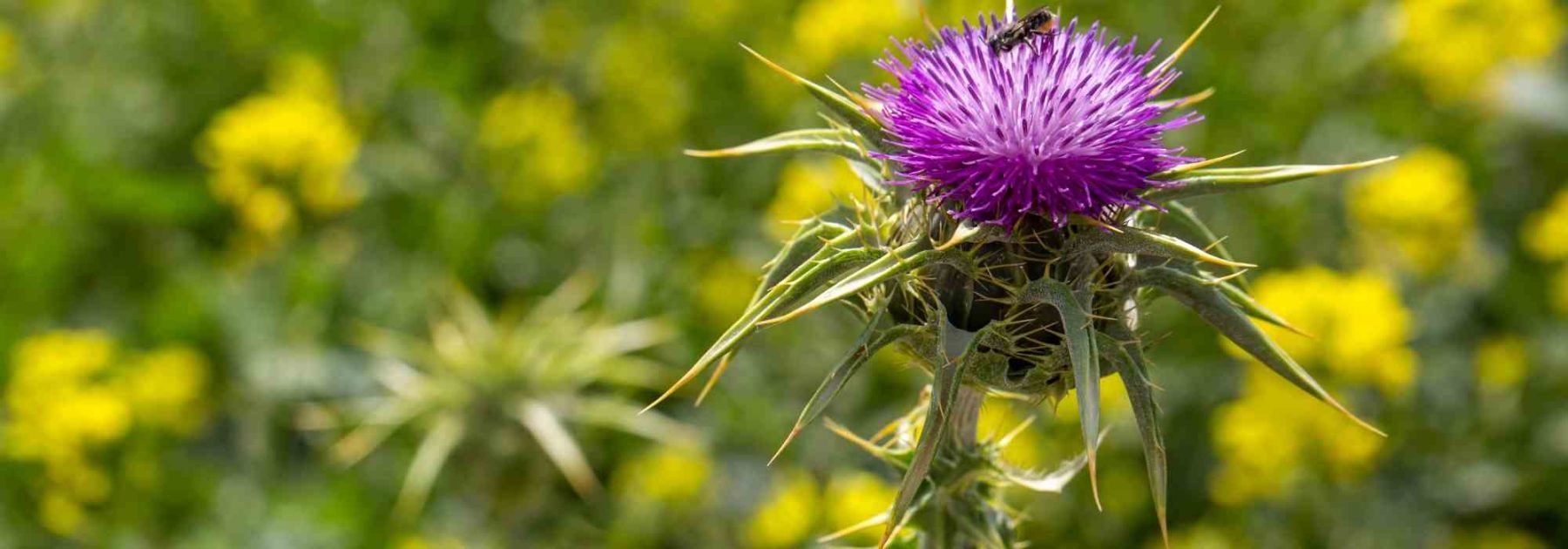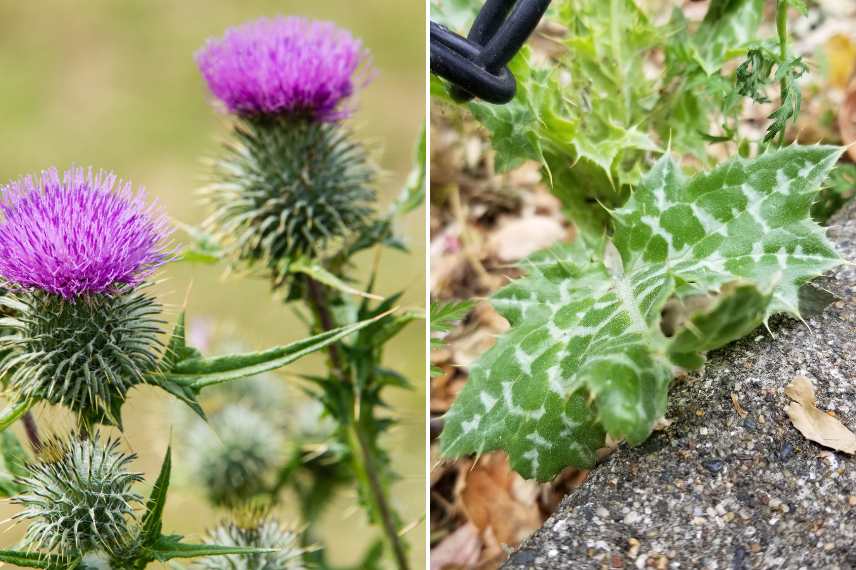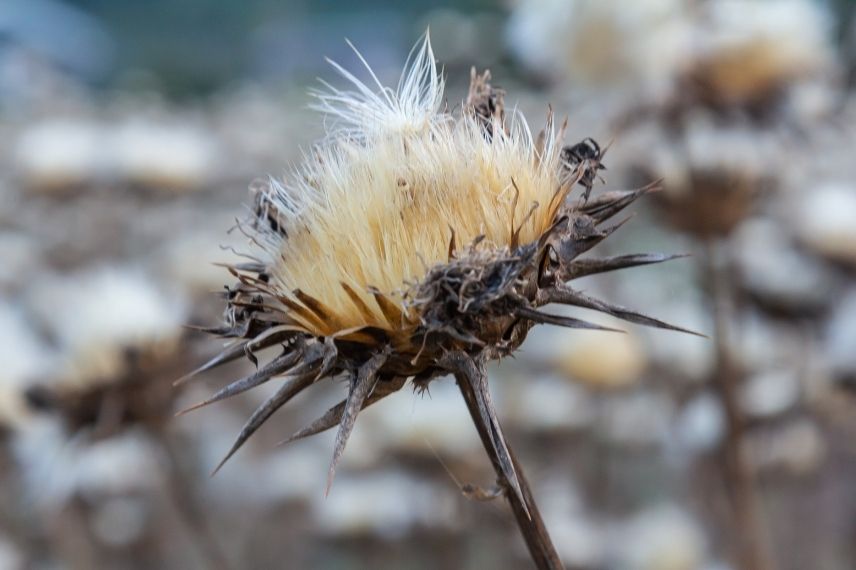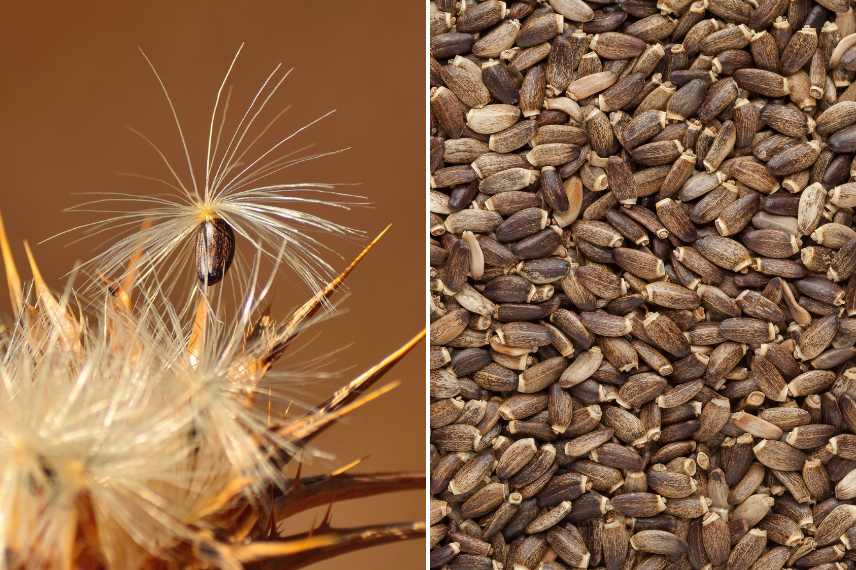
Cardo mariano: una planta medicinal para cultivar por sus beneficios
All the benefits of the fruits and leaves of this biennial plant
Contents
Thistles are prickly! That’s a fact, but the generic term “thistle” refers to several plants of different genera. Among these spiny herbaceous plants, the milk thistle (Silybum marianum) holds a special place. Indeed, it is a medicinal plant, known since antiquity and recognised by science, for its protective action and its benefits in supporting liver health. Thanks to silymarin, it is believed to help regenerate liver cells, protect the liver, and combat toxins. It is also thought to possess antioxidant and anti-inflammatory properties. This makes milk thistle a remarkable ally for our body.
Discover the properties and benefits of milk thistle for our well-being, its various uses, and any potential contraindications.
Presentation of Milk Thistle
There are thistles and then there are thistles! Beneath their prickly appearance, from leaves to inflorescences, the term “thistle” actually refers to several herbaceous plants belonging to different genera, most of which are part of the large Asteraceae family. This includes true thistles (Carduus), ornamental thistles (Echinops), cirsium (Cirsium), carline thistles (Carlina), as well as sea hollies (Eryngium) and teasels. Among these spiky plants, milk thistle (Silybum marianum) holds a special place. It is, in fact, the sole representative of the genus Silybum! Yet, it boasts numerous benefits, both aesthetic and medicinal.
To fully appreciate the benefits of milk thistle, it’s essential to understand it well.
A Herbaceous Plant from the Asteraceae Family
Native to Mediterranean regions and parts of Asia, milk thistle is a rather robust herbaceous plant, thanks to its thick, spherical, and branched root. As a biennial plant, it produces a rosette of oval, leathery leaves in its first year. These leaves are irregularly toothed and spiny, with a glossy green colour and white marbling along the veins. In its second year, milk thistle develops an upright stem, leafy at the base and woolly towards the top. In summer, between June-July and August-September, solitary flower heads bloom at the top of the stems. The purple flowers, surrounded by toothed and spiny bracts, produce brown, speckled fruits in the form of achenes, topped with a white, shiny pappus.
While milk thistle is often found growing wild on roadsides, wastelands, fallow fields, and rocky slopes, it can also be sown and cultivated in a rural or urban garden. It can reach a height of 1.5 to 2 metres.
Sowing and Growing Milk Thistle
Milk thistle is typically obtained as seeds for sowing. Sowing can be done in February under cover or in April directly in the ground. February sowings will need to be transplanted into pots in March before being moved to their final position in April. For direct sowing, seeds are planted in rows spaced 50 to 60 cm apart, and the seedlings are thinned to 60 cm intervals.
Milk thistle adapts well to dry, chalky, and poor soils due to its origins, but it thrives better in rich soil. The key is to ensure the soil is well-drained, possibly lightened with sand. It also requires full sun.
Read also
How to dry blue thistle flowers?How to use milk thistle?
While all the tender parts of milk thistle (young leaves and stems, flower heads, roots) are edible, it is the leaves and achenes that are used in herbal medicine, as they contain the active compounds. These fruits are said to be particularly rich in flavonoids, especially silymarin, which is believed to have hepatoprotective effects. This medicinal property is officially recognised by the WHO (World Health Organization).
How to Harvest Milk Thistle?
Milk thistle leaves are harvested during its flowering period, which occurs between June and September, depending on the region. These are the small rosettes of leaves that develop on the flowering stems, and they should be harvested young, before they become tough and spiny. Once harvested, they should be dried in a dark, well-ventilated room, away from any moisture. If you don’t have a suitable space, you can dry the leaves in an oven at 50°C with the door slightly ajar.
The seeds are collected from the dried flower heads, which turn brown and dry. Often, the seeds naturally detach from the feathery pappus that tops the achenes. Simply cut the dry flower heads and place them on an old cloth or in a large bag to continue drying for a month. The white bristles are clearly visible and can be allergenic. Wearing gloves, remove these bristles to collect the seeds. A hairdryer can be used to help remove the bristles.

Dried milk thistle flower
How to Use Milk Thistle Seeds and Leaves?
- Dried leaves can be consumed as an infusion using one teaspoon per 250 ml of boiling water. Let it steep for 10 minutes, strain, and drink. Three cups a day, half an hour before meals.
- Whole seeds can be prepared as a decoction using one teaspoon in 150 ml of cold water. Boil for 5 minutes, strain, and drink. Three cups a day, 30 minutes before meals.
- Seeds can be ground into a powder and consumed as an infusion. Use two teaspoons of powder per day.
It is recommended not to consume milk thistle continuously for long periods. A course of 3 to 6 weeks is generally advised, followed by a break of a few weeks before resuming if necessary. This break prevents the body from becoming accustomed to the active compounds and maintains the plant’s effectiveness.
What are the benefits of milk thistle for the body?
Consumed since antiquity by the Greeks, Romans, and in Ayurvedic medicine, milk thistle has a reputation as an essential plant for supporting liver protection. It benefits from traditional use in treating liver diseases. However, the benefits of milk thistle are not limited to this area.
The Liver-Protective Action
Silymarin, the major active compound believed to be found in milk thistle, is thought to act on liver cells. It is said to play a role in liver regeneration and detoxification, as well as repairing liver cells by eliminating toxins. This is particularly relevant after significant alcohol or medication consumption, or liver poisoning. These flavonoids are believed to contribute to the production of new liver cells.
Milk thistle is logically considered a key ally in treating liver diseases, such as hepatitis, cirrhosis, or liver conditions related to gallstones…
The WHO officially recognises its liver-protective virtues in chemotherapy protocols for cancer to reduce side effects.

Milk thistle seeds are believed to contain silymarin, the major active compound
Digestive Support
Milk thistle is also renowned for helping to improve digestion and promote healthy intestinal transit. Indeed, milk thistle is thought to stimulate bile production by the liver. By increasing bile secretion, the digestion of fats and the absorption of fat-soluble nutrients become more efficient. Milk thistle is therefore believed to have a cholagogic effect, similar to artichoke leaves in herbal tea.
Milk thistle is also known to help relieve digestive issues in cases of irregular transit, difficult digestion, or digestive inflammation. It is also a natural support for the gut microbiota.
Antioxidant and Anti-Inflammatory Properties
When the body accumulates too many free radicals, generated by pollution, an unbalanced diet, smoking… the body enters oxidative stress. Thanks to its richness in antioxidants, milk thistle is believed to help neutralise free radicals and support the immune system.
Still thanks to silymarin, milk thistle is thought to have anti-inflammatory properties, combined with its antioxidant effects, which may confer benefits in protecting against chronic diseases such as cardiovascular diseases, diabetes, or neurodegenerative conditions.
What are the side effects and contraindications of milk thistle?
Although milk thistle is generally well-tolerated, there are a few precautions to consider.
Possible side effects
Minor digestive issues may occur, such as bloating, mild diarrhoea, or nausea. These effects are usually temporary and disappear after a few days.
Contraindications
- People allergic to Asteraceae.
- Pregnant or breastfeeding women.
- Individuals with hormone-dependent cancer.
- Interaction with certain treatments (anticoagulants, antidiabetics, hepatotoxic drugs).
In these cases, it is strongly advised to consult a professional for medical advice before consuming milk thistle.
Did you know?
Also known as silver thistle, holy thistle, or Our Lady’s milk, or Mary’s thistle, the milk thistle is said to derive its name from a legend: while fleeing hastily from Egypt to Palestine, the Virgin Mary wished to breastfeed Jesus. Drops of milk are said to have fallen on a bush of thorns behind which she was hiding. This legend also explains the white marbling that adorns the foliage of the milk thistle.
- Subscribe!
- Contents


































Comments